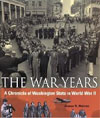book
The War Years: A Chronicle of Washington State in World War II
by James R. Warren ('49 Speech/Comm.) :: University of Washington Press

Most Washingtonians don't realize that their state—with a wartime population of just over 1.7 million—did as much or more per capita than any other state to help win World War II, says James R. Warren.
The WSU alumnus ('49 Speech/Comm.) and Bellevue resident is author of a new book, The War Years: A Chronicle of Washington State in World War II.
The state's 15 shipyards were busy building warships. Boeing turned out thousands of B-17 and B-29 bombers. Pacific Car and Foundry produced hundreds of Sherman tanks. And Hanford purified the plutonium for the atomic bombs dropped on Japan by B-17s. When the war started in 1941, the state had not produced an ounce of aluminum. When victory arrived in 1945, Washington was the country's third-largest producer of aluminum.
Victory had a telling price, however. The War Years lists the names of more than 6,200 of the state's young men and women who were killed. Warren includes stories of 25 Medal of Honor winners from Washington, including Douglas Munro of Cle Elum, the only Coast Guardsman in U.S. history to earn the highest award for bravery. Also listed is Gregory "Pappy" Boyington of Tacoma and Okanogan, Marine Corps pilot of the famed "Black Sheep" Squadron. He shot down 26 Japanese planes during the war and later wrote two best-selling books that became television series.
Warren mentions his alma mater several times and tells how the draft affected the campus.
"At Washington State College in Pullman, the war's impact was obvious beginning in 1942. At men's dormitories and fraternities, stripped beds and suitcases piled at the door were common sights. Instead of football rallies, students gathered at the Pullman train depot to say goodbye to friends," Warren writes. "Many male students did not study hard because they doubted they would be on campus long enough to earn a degree. Others applied themselves with vigor in hopes of qualifying for Officer's Candidate School or pilot training or other personal objectives. Before the 1942 fall semester ended, the men's dorms and fraternities were almost vacant."
A native of Goldendale, Warren served with the 42nd Rainbow Division in World War II and was wounded and captured by the Germans during the Battle of the Bulge. Following his discharge from the Army in 1945, he graduated from WSC, received a teaching fellowship at the University of Washington (1950), and worked as a radio announcer and newsman in Seattle for 13 years while completing a doctorate (1962). Later, he was public relations director with the Seattle Public Schools, helped plan Seattle's community colleges, and served a 10-year term as the first president of Edmonds Community College. In 1980 he was named director of Seattle's Museum of History and Industry, a position which allowed him to satisfy his "abiding interest in history."
In retirement Warren continues to write about the Pacific Northwest, including a sesquicentennial history of Seattle. "When I find time," he says, "I hope to write my personal wartime story."